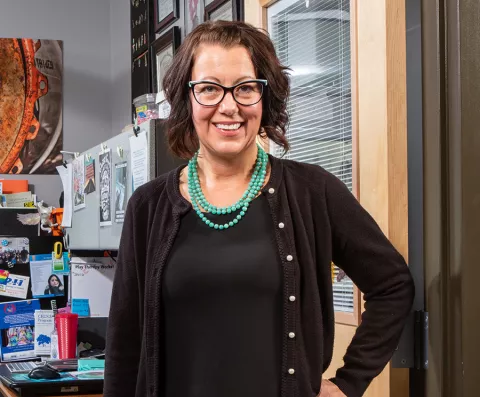Key Takeaways
- The American Rescue Plan Act, signed by President Joe Biden one year ago, is the single largest investment ever in public education.
- NEA members advocated for the $170 billion investment in our nation’s public schools and universities.
- ARP funds have been used to upgrade school ventilation systems, lower class sizes, and add instructional specialists, mental health professionals, and school nurses.
Students, families, and school communities have seen COVID relief funding flow into their classrooms for a full year now, and the positive impacts on their learning environments, mental health, and overall well-being are clear.
The American Rescue Plan Act, signed by President Joe Biden one year ago, is the single largest investment ever in public education. The legislation requires that local education officials seek educator input before funding decisions are made, showing how much the Biden administration values the voices of the experts in our classrooms and school buildings.
The relief package narrowly passed in Congress, with every single Republican legislator voting against it. While it was a partisan battle in D.C., the money has been used to help all students in public schools in every state across the country.
Educators have worked hard to organize and advocate for using School Rescue Funds–which includes ARP and earlier relief packages–on the supports and learning environments students deserve. Together, NEA members advocated for the $170 billion investment in our nation’s public schools and universities, securing the funds necessary to keep our students safe, lower class sizes, add instructional specialists, mental health professionals, and school nurses, and more.
“One year ago, we celebrated as Congress passed and President Biden signed into law the American Rescue Plan, the largest federal investment in public education in history. Today, we continue to witness the incredible, life-changing impacts this historic investment has had across the country, helping to lift countless children and families out of poverty while working to address the immense inequities that have systematically affected the most vulnerable students and communities of color,” said NEA President Becky Pringle.
Educators are on the front lines holding their school districts accountable to ensure ARP funding goes where it will have the most impact for their students on a daily basis.
Ninety-nine percent of schools have been able to safely reopen for in-person instruction with the help of $122 billion allocated to improving ventilation systems, purchasing PPE, hiring more staff, reducing class sizes, and more. An additional $10 billion was provided to support COVID screening tests for teachers, staff, and students.
Here are five ways that educators have made a difference for their students and colleagues over the last year by advocating and bargaining for the use of ARP funding to support safe and equitable schools:
#1 Recruit and Retain Educators of Color
Iowa City Education Association (Iowa)
“For many years, I was the first Black Latina teacher many students had. We are working on how we diversify our teaching staff, so some students do not have to go 10 grades without seeing representation,” said Carmen Gwenigale, a 22-year veteran educator in Iowa.

Gwenigale is one of 13 fellows in the Iowa City Community School District (ICCSD) Leadership Fellows Program, which was established thanks to ARP funding and the advocacy of the Iowa City Education Association. The program creates opportunities for students to pursue a career in education. Working with the University of Iowa, the Leadership Fellows program established a pipeline for teachers into public education, and seeks out students of color. They are also working to facilitate restorative justice initiatives and summer school programming, and implement the district’s comprehensive diversity, equity, and inclusion plan.
“We connect kids with their passion in teaching. We let them see a career in education as a way to make a difference,” said Gwenigale, who has experience teaching in Iowa and Puerto Rico. She knows that all students, and particularly students of color, perform better in schools with a diverse teaching force.
Gwenigale sees the program as one way to support students after a year that upended the way we educate our children, rather than trying to shift back to the status quo.
“Our program gets kids to rethink teaching as a career. We connect kids with their passion in teaching. We let them see a career in education as a way to make a difference,” said Gwenigale. Members in Iowa City also used ARP funds to secure:
- Twenty-eight new academic support specialists—one for every Iowa City school—and six new full-time school nurses
- Additional language arts and math teachers at every secondary school, enabling smaller classes and targeted support for struggling students
- Funding for summer school in 2021 for every first-grader who was not proficient in math or in reading, plus additional non-proficient students in other grades
- A two-week summer “Boost” program at every middle and high school to offer social-emotional learning and academic coaching to rising 7th-10th graders
- A new position of restorative-justice coordinator
#2 Make Student Mental Health a Top Priority
Natrona County Education Association (Wyoming)
In Wyoming, the Natrona County Education Association was determined to support students’ mental health. With parent allies at their side, educators successfully made the case that School Rescue Funds should be used to ensure there is a school counselor available to students daily.

Since the pandemic hit, more students have sought out the counselor because of serious home stressors, said Carrie Maki, a school counselor at C.Y. Middle School. More students than ever before are dealing with the loss of a family member to illness or suicide, and shouldering the devastating effects of a parent losing a job or being incarcerated.
To ensure that they are able to address student mental health needs, Natrona County added more funding for contracted services from a local mental health agency. The district also hired a cadre of school counselors they can deploy to meet urgent needs.
“Most of these families can’t typically afford outside counseling,” Maki says. “So if we did not have these services available at school, these students might not get what they need.”
Similarly, across the country superintendents are prioritizing mental health, and 82% report they plan to use ARP funding for whole child health. With the help of American Rescue Plan K-12 funding, schools have already seen a 65% increase in social workers and a 17% increase in counselors.
With a 20-year history in labor-management collaboration as well as collective bargaining, NCEA had a strong voice in School Rescue Fund spending and scored an incredible number of wins for students and educators, including:
- A full-time nurse in every school in the district
- Dedicated funding for academic recovery at the elementary level
- An employee assistance program that provides counseling for employees and their immediate family members at no cost
- Made sure a school nurse was at the table to help guide health and safety provisions in the district’s Smart Start Reopening Plan in 2020
#3 Improve Air Quality
Columbus Education Association (Ohio)
“This was an unprecedented opportunity to get things that students of Columbus deserve, and our members deserve for our students in writing,” said Phil Hayes, who was on the Columbus Education Association (CEA) bargaining team that negotiated an MOU to provide dedicated funding for desperately needed HVAC system upgrades and many other supports for students and educators.

Across the country, more than 41 percent of school districts need to update or replace their HVAC systems in at least half of their buildings. Through the American Rescue Plan, 53 percent of superintendents across the country plan to direct the federal funding to HVAC and ventilation.
The team also bargained for a micro-grant process that allows educators to apply for funding in increments of $300-$600 for projects, field trips, or classroom resources. Negotiations this year also ensured that members have a seat at the table when discussing how ARP funds are spent and where new systems are needed most.
“This was like winning the lottery for our school district, hundreds and hundreds of millions of dollars, and it’s important to be at the table to make sure it goes where it needs to go,” said Hayes, vice president of CEA. He says the strength of all of the members working together allowed them to secure these wins for their students.
“The more transparent you are about it and the more things that benefit students directly like school counselors, primary literacy specialists, upgraded HVACs, mini-grants for teachers, those are the things that will sell this whole thing itself,” said Hayes.
CEA achieved monumental wins for students and educators, including:
- 33 new school counselors, 88 literary specialists, and other specialized instructional support (SISP) positions
- Professional development for CEA members on racial disparity, equity, diversity, and inclusion
- Stronger COVID-19 protocols that rely on public health data
#4 Advocate for COVID Leave
Northwest Arctic Education Association (Alaska)
“Every time [the superintendent] went into a building, teachers essentially bombarded her with, ‘If you’re going to do something to support us, you need to give us COVID leave.’ Any chance anybody got to speak to her, we brought up that we need COVID leave,” said Emma Melkerson, an elementary teacher in Kivalina, Alaska.
ARP funds have helped educators implement COVID mitigation strategies during in-person instruction, and will help ensure that school communities are safe, just, and healthy places to learn long after the pandemic recedes. When it became clear that the school district wasn’t including the educator union in conversations about how ARP funding was spent, it fired Melkerson up.
“Our district claims to want to take care of our educators, take care of our kids, take care of our staff, and it was really shocking to me that at the time there was no discussion of [COVID leave],” said Melkerson, who is president of the Northwest Arctic Education Association. With a 10-day required quarantine, educators are left with essentially zero sick days if they or a family member became sick later in the school year.
In her rural district north of the arctic circle, Melkerson and her peers asserted that educators shouldn’t have to use their personal days to keep themselves and their students safe and they should be able to weigh in on decisions about their work conditions. Members met and agreed that they needed a COVID leave bank, increased staffing, and mental health services for staff.
Educators across the district overwhelmed their superintendent with emails, survey responses, and in-person testimony to successfully advocate for COVID-related leave, which is now with the Board of Education for approval.
In other counties in Alaska, members continued to rally around COVID-related supports for retaining educators and supporting students, including:
- In Craig, Alaska, members were able to get retroactive COVID leave if they were forced to use sick days to quarantine or to care for a family member
- Members in Hedy, Alaska, negotiated bonuses for working during the pandemic
#5 Increase Staff to Support Students
United Education Association of Shelby County (Tenn.)
It was a “great day for educators and students” in Memphis, Tenn., when member advocacy led the school district to allocate ARP funds to both help retain teachers and educational assistants, and hire hundreds of additional specialized education assistants to benefit students. Superintendents across the country report that 59 percent of schools are using ARP funds for hiring and retaining teachers and counselors to better support students.
“Our success happens through collaboration with the superintendent, district leaders, and school board members. When we ALL work together we get things done,” said Danette Stokes, president of the United Education Association of Shelby County, thanking the superintendent for listening when educators spoke up.
Union members across Tennessee have also brought home wins for students such as:
- Lower student-teacher ratios
- Expanded tutoring programs
- Upgrades to facilities
NEA State Affiliates in Action
NEA is also working at the state level to change policies that benefit students and educators. Some of their wins include:
- Expansion of trauma-informed practices to address students’ social and emotional needs across the state of Michigan.
- Passage of HB 100 in Delaware, to ensure mental health resources such as staff, healthcare, and curriculum updates in public schools, and the introduction of three additional bills to further expand resources statewide.
- Introduction of legislation to address workload and decrease class sizes across Maryland.


